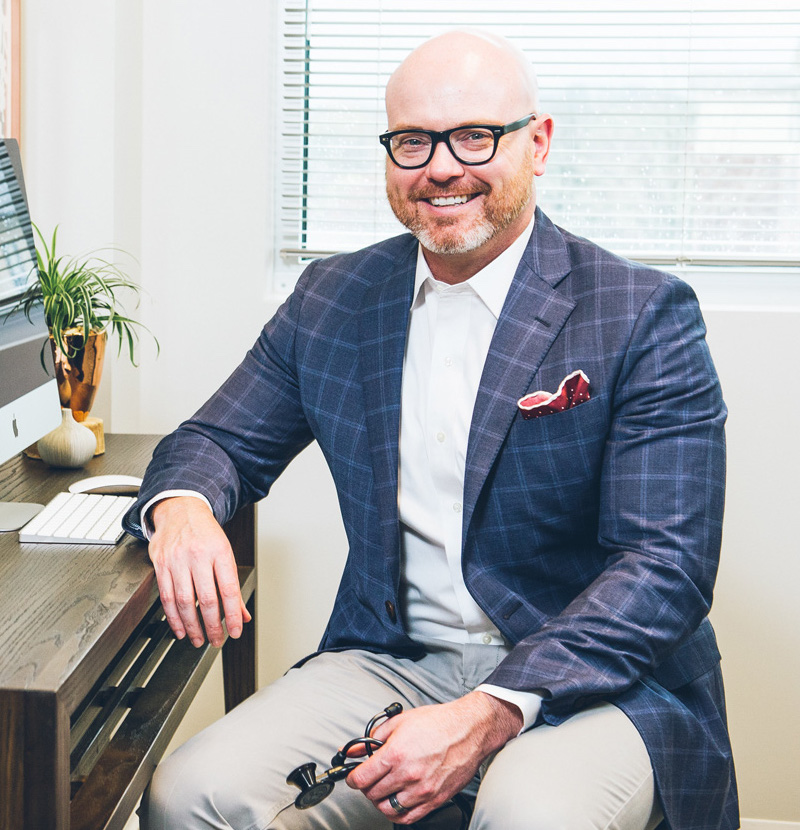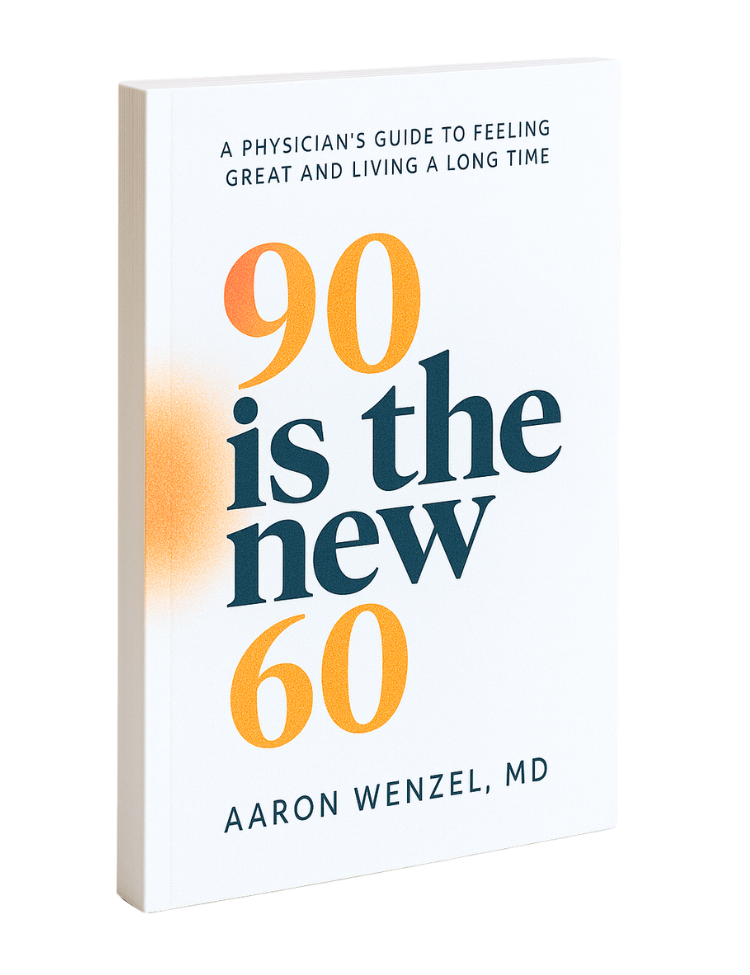Download file | Play in new window | |
I’ve spent nearly two decades as a physician observing patterns, gathering insights, and developing convictions about what’s truly possible for human health and longevity. This journey culminated in my new book, 90 Is the New 60: A Physician’s Guide to Feeling Great and Living a Long Time.
What if we could add not just years to our lives, but decades of vibrant, purposeful living? What if the decline we commonly associate with aging isn’t inevitable but optional?
These are the questions that drove me to write 90 Is the New 60 — because after all my experience, I truly believe that with the right knowledge, adding decades of vibrant living to the back half of life is a legitimate option for many, many people.
The Genesis of ‘90 Is the New 60’
On the front end of my medical career, I spent over a decade providing acute care in an emergency room setting. I saw thousands of deaths. Hundreds of ways to die. It was the end of the road for so many.
One of the saddest components of this work involved a realization that, while accidents and outlier conditions certainly occurred, so much of the true suffering I witnessed seemed avoidable, or at least delayable.
That thought began to percolate in the back of my mind. Could disease, and therefore suffering, be delayed and/or avoided if people had more knowledge, more access, more speed to action? What would that look like? How could we get there?
As hundreds of difficult ER experiences stacked one on top of the other, patterns began to become clear. Really, only a handful of ailments tend to take people off the earth. Of those, most are rooted in the same fundamental issue.
Unfortunately, the ER isn’t the place where doctors can proactively address beginning-stage problems. But when I established Brentwood MD, I finally had the opportunity to work at the other end of the spectrum, to ask questions like what would happen if we addressed this issue early? How long could people live, and live well?
DOWNLOAD OUR FREE EBOOK
Concierge Medicine is the future of healthcare.
Learn more about this refreshing alternative to traditional primary care, and decide if it's right for you.
Key Considerations to decide...
Is Concierge Medicine Right for You?
For the first time in my career, I wasn’t reacting. I was helping people design their health futures.
What I discovered is that strategic, proactive health management changes people’s medical destinies. And adding 10, 20, even 30 years of healthy living to the back half of life becomes less science fiction and more science fact for those willing to embrace the right conviction, commitment, team, and time required.
Today, I’ve shared so many of my thoughts around this topic on my blog, on podcasts, at public talks, and in my practice. They’ve grown and refined as I’ve gained experience and knowledge, and I finally felt a need to codify them in one streamlined format. That format is 90 Is the New 60, a digestible little 180-page volume you could read over a weekend.
Redefining What’s Possible
I’ve used the somewhat shocking title 90 Is the New 60 for years (just look at some of my past posts!), but why? It’s not to say that every single person must and will live to 90 years old. Rather, it’s to jolt our collective minds out of the idea that it’s inevitable to decline in our 60s and 70s.
What if it isn’t inevitable at all? What if we’re all simply following a default trajectory because we don’t know an alternative exists? What if we could reduce the slope of that decline?
As humans, we identify patterns and norms by observing what’s around us. When what’s around us comprises human beings living similar lives with similar health issues getting similarly weaker and more ill around a similar timeline, we assume that’s normal. And I’ll tell you this: When you put in similar effort to all those people surrounding you, then you will get similar results.
But the truth is, you have a different option. You can put in extraordinary effort, and get extraordinary results.
The aging process and chronic disease are actively pulling you into the earth. In a way, it’s like the earth is calling back her parts. Without intervention, you’ll look the same, get the same diseases, and experience the same end-of-life scenarios as most people around the same time they experience them.
Living vibrantly into advanced age is an active process. It demands intention and commitment.
But it is possible.
Hunting the Big 3: Heart Disease, Cancer, Dementia
If I’m interested in extending life, it makes sense to me to focus on delaying or avoiding the top things most likely to kill people. When we examine the top 10 causes of death, we see that heart disease is statistically the most likely disease to take you and me off the earth. Number two is cancer, and a few spots later comes Alzheimer’s dementia.
I call these “The Big Three,” and it’s an area in which I’ve invested thousands of hours of research, study, observation, and effort.
Regarding heart disease, for example, my practice became maniacal about understanding heart attacks, the atherosclerotic process, and soft vs. calcified plaque. We sought to discover which health metrics truly matter in screening for cardiovascular disease, what baselines we needed to establish, and when further investigation is warranted. We’ve worked to stay abreast of new screening technologies — like Cleerly — that offer George Jetson-level insights into risk.
We’ve approached cancer and dementia similarly, looking at risk factors, lifestyle modifications, warning signs, and up-to-date screenings. And, lurking behind each of the Big Three, we identified one foundational contributor.
The Root of It All: Metabolic Disease as the Gateway
Of the top 10 killers of humans, seven are directly or indirectly linked to metabolic disease. This is the root cause of so much suffering. And I’ve found it’s the bullseye at which we need to aim to achieve true, vibrant longevity.

The term metabolic disease stems from metabolism, which is the biological process of converting the potential energy within food into usable energy within our bodies. Metabolic disease, then, is when that metabolic engine becomes dysregulated.
Metabolic disease mainly occurs in environments of abundance. In environments of scarcity, you have starvation, malnutrition, and all the diseases and mortalities that come along with them. In environments of abundance, you have the diseases and mortalities of a dysregulated metabolism.
Diabetes, perhaps the most well-known representative of metabolic disease, involves the body’s inability to regulate blood sugar. Other metabolic conditions include problems like high blood pressure, insulin resistance, and obesity.
Today in America, we’re looking at upward of 70% of adult Americans with some form of metabolic dysregulation. This is a relatively new phenomenon in human history.
From 1900 to 1950, obesity rates went from around 1% to 5% (records on this are spotty — because we didn’t even see a need to track it yet!). Since 1950, we’ve gone from about 5% to well over 35%, according to the latest figures. That’s a stunning increase!
Why has this happened? In a word, surplus. Throughout most of human history, scarcity was the challenge, not abundance, and our bodies had adapted to keep us alive in that scenario. But just in the last century — an incredibly short window in humanity’s existence — we’ve begun taking in too much energy. We simply aren’t adapted to handle it, especially when much of that energy comes from low-quality foods that human bodies have never seen before.
Alongside the rise of abundance and “new foods,” metabolic disease has flourished. And, unfortunately, metabolic disease is the gateway to just about every other disease you most want to avoid.

To extend human life and health, then, we must get a handle on abundance and what it does to our bodies.

When we drill down on metabolic disease, it turns out that the core issue — what I call the holy grail of health — is your body’s relationship between blood glucose and insulin. We can get everything else right, but if we miss on insulin resistance, we’re unlikely to make meaningful strides in the fight to delay or prevent those top killers.
Health Multipliers: The 80/20 Rule for Longevity
To attack metabolic disease and reach for long-term wellness, I place what I call “health multipliers” in a central role.
A health multiplier is simply an activity in which one unit of energy or effort goes in, and more than one unit of result comes out. The more output units you get for every input unit, the more powerful the multiplier.
People who make a significant positive impact on their health tend to focus on one of three areas:
Each of these areas contains various activities that fit neatly in the 80/20 rule — 20% of effort creates 80% of the impact. By focusing on these high-leverage activities across all three, you create momentum that compounds.
The key is to start with what you’re naturally curious about or good at. For instance, if you’re already interested in lifting weights, great! Strength training is one of the most beneficial activities you can do for longevity — yes, including and especially for women! Optimize your resistance training, and then use that positive momentum to tackle the area you’re next most curious about.
This approach isn’t about gritting your teeth and being miserable; it’s about zeroing in on what gives you a tailwind, then using that momentum to optimize further areas.
It’s about finding where you can swing one axe and more than one tree comes down.
Hormones: Misunderstood Multipliers of Vitality
One multiplier that falls outside those three buckets — but alongside all of them — is hormones.
Hormones matter. They are, in large part, what create the vitality of our youth, but then they decline. For women at menopause, they essentially disappear.
The basic infrastructure of our physical body — muscles, bones, tendons, organs, muscles — needs hormones to operate properly. When hormones disappear, we simply don’t function well.
For instance, lifting weights creates a healthy input for our muscles, but it’s hormones that provide the signal for those muscles to grow, and protein that provides the building blocks to do so. Miss any piece of this puzzle, and you can work out all you like without achieving optimal results.
Unfortunately, hormone replacement therapy remains wildly controversial today. Women, especially, have been done a disservice in this area, particularly by the misinterpretation of a study called the Women’s Health Initiative.
Prior to 1990 — that’s 1990, not 1909 — there had never been a government-sponsored, randomized, placebo-controlled trial on women’s health outside of childbearing. Essentially, women were treated as female males, with the only difference being that they could bear children.
As a result, women’s healthcare is far behind where it should be. But when women began discovering bioidentical hormone therapies around this time, they felt like they’d found a new lease on life. The government, wanting to ensure these therapies were safe, then started the Women’s Health Initiative.
Despite good intentions, the trial had some serious flaws, the topmost of which was this: Not a single woman in the study received real estrogen or progesterone. Instead, they received synthetic pharmaceuticals that were called estrogen and progesterone, but which were fundamentally different and ultimately problematic. The study then concluded that much of hormone therapy was unsafe, undermining the potential relief so many suffering women (and men!) could have benefited from since then.
The fear this study inspired still lingers today, a specter I hope my book can in some part dispel. If a woman reads it and decides against hormone therapy, that’s perfectly fine. My ambition isn’t that every woman would be on hormone therapy; it’s that every woman would at least have the information and the option to make an informed decision for herself.
Sick Care vs. Health Care: Why the Current System Fails Us
Around 100 years ago, healthcare was about surviving quick killers like childbirth, infections, trauma — and, yes, heart attacks and strokes. It was a system developed to prevent death.
With the advent of antibiotics and advances in acute care, we’ve expanded life expectancies to a point far beyond what that original healthcare model could have fathomed. Yet the model itself remains largely the same in its focus: prevent death.
At the same time, life has gotten physically less demanding for millions. We sit more, move less. We have abundant food, but low in quality. We have more access to more stuff than ever before in history, and we live longer with it.
In the midst of this unprecedented abundance and life expectancy, we’re besieged by questions like what’s good for me? What’s bad? How much is too much? How much is too little?
And the traditional medical model simply isn’t equipped to handle it — because it isn’t truly healthcare. It’s sick care. If you’re sick, its denizens can keep you alive. But they aren’t trained or even incentivized to make you healthy.
The good news? This is a higher-level problem than dying at age 20. But it is still a problem.
People today don’t just want to stay alive. I can’t count the number of times I’ve had someone tell me, “I don’t want to live to be 80,” because they have no desire to experience the decline they so often see at that age. But that’s all the sick care model can offer.
For years, people have been seeking ways to improve their health, but all the sick care model could offer were generic, canned responses (Eat less, exercise more!) and a few basic screenings. If you wanted improvement beyond that, you were on your own.
The sick care model simply isn’t built for health and wellness. It lacks any incentives to align it with health-conscious people who want to get healthier and prevent future disease. I used to get really angry about this, but I’ve come to realize that’s just how the model developed. So, rather than staying angry, I’m now doing my best to champion an alternate path.
Self-Advocacy for Long-Term Health
The nature of the sick care model is why I pound the drum of self-advocacy so hard. If you’re not raising your hand, rattling cages, and asking questions, the existing system simply isn’t designed to help you make any progress.
I know this can be discouraging. But if you’re asking questions and not getting good responses, the solution isn’t to stop asking questions. It’s to ask different people, more people.
Personally, I’ve started seeing my role as akin to that of a wealth advisor — a kind of health asset manager. I look at your current state, your goals, your risk tolerance, your resources, and together we build a personalized plan for your future.
Just like in finance, some people are ready to go all-in on day one, and others need to ease in a bit more conservatively. Some want big results fast. Others want to take their time.
There’s no right path, but there is a right fit. That’s why one of the most important messages in my book is this: Find your team.
Find people who listen. People who align with your goals. People who advocate for you and help you stay the course. Find the people who will help you leave sick care behind to truly optimize your health.
Who Is This Book For?
My aim in writing 90 Is the New 60 is to empower you with the knowledge to make informed, personalized decisions not just to live longer, but to live better. So…

If you’re human and you have an ambition to live a long time and feel great doing it, this book is for you.

If you’re worried about your health slipping but can’t find answers on what to do next, this book is for you.

If you’re tired of being talked at or dismissed by a sick care system that doesn’t see you as an individual, this book is for you.

If you want clarity, action, and ownership over your own health, this book is for you.
The Path Forward: Don’t Be Afraid to Try
If you decide to read this book, my hope is that you would do so with a simple curiosity. I don’t expect everyone to agree with everything I say, and I don’t expect you to implement everything immediately even if you do. How overwhelming!
I simply hope you’ll stay curious.
Curiosity opens the door to action, and action opens the door to momentum.
This book is my invitation to take the driver’s seat in your health journey, to think deeply about what you want your last decade on this earth to look like, and to begin building toward that today.
If you find yourself believing that adding 30 years — 30 good years — to your life is possible, and you believe it’s worth it, don’t be afraid to try. Think about it. Even if you “miss” and only add 20 years, or 10, or 5, that’s not failure — that’s victory! What would you do with even 5 extra vibrant years of time on this earth?
You can order 90 Is the New 60 on the Brentwood MD website or on Amazon in paperback and ebook formats. If you find it valuable, leave a review — both to help others decide whether it’s for them and to let me know what you think!

Dr. Aaron Wenzel is a concierge physician specializing in the care of fast-moving entrepreneurs, executives, and public figures in the Nashville, TN area. Dr. Wenzel’s diverse life experience and extensive training in family medicine, emergency care, nutrition, and hormone replacement therapies give him the unique platform to provide unmatched care for his patients.











